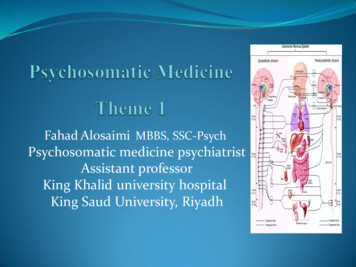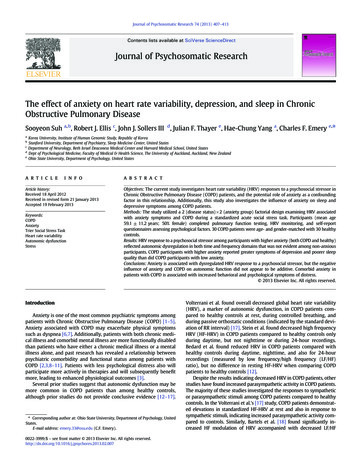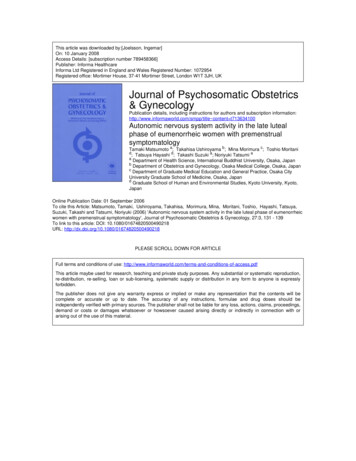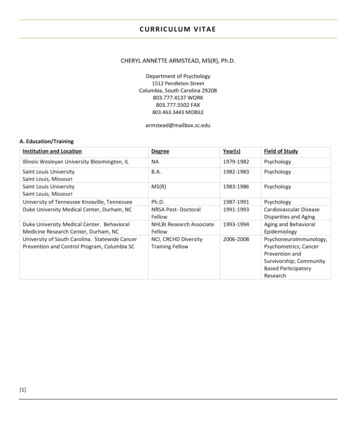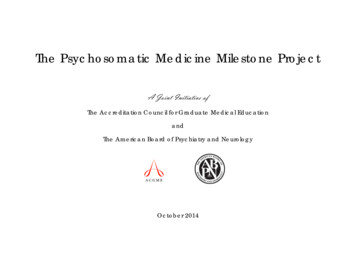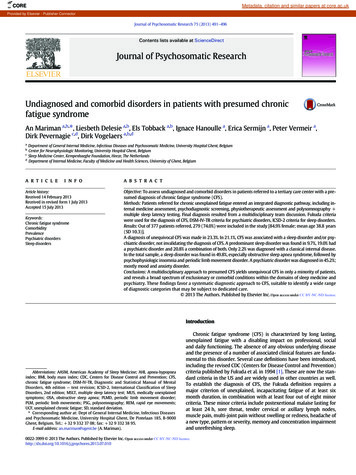
Transcription
COREMetadata, citation and similar papers at core.ac.ukProvided by Elsevier - Publisher ConnectorJournal of Psychosomatic Research 75 (2013) 491–496Contents lists available at ScienceDirectJournal of Psychosomatic ResearchUndiagnosed and comorbid disorders in patients with presumed chronicfatigue syndromeAn Mariman a,b,⁎, Liesbeth Delesie a,b, Els Tobback a,b, Ignace Hanoulle a, Erica Sermijn a, Peter Vermeir a,Dirk Pevernagie c,d, Dirk Vogelaers a,b,daDepartment of General Internal Medicine, Infectious Diseases and Psychosomatic Medicine, University Hospital Ghent, BelgiumCenter for Neurophysiologic Monitoring, University Hospital Ghent, BelgiumSleep Medicine Center, Kempenhaeghe Foundation, Heeze, The NetherlandsdDepartment of Internal Medicine, Faculty of Medicine and Health Sciences, University of Ghent, Belgiumbca r t i c l ei n f oArticle history:Received 14 February 2013Received in revised form 1 July 2013Accepted 15 July 2013Keywords:Chronic fatigue syndromeComorbidityPrevalencePsychiatric disordersSleep disordersa b s t r a c tObjective: To assess undiagnosed and comorbid disorders in patients referred to a tertiary care center with a presumed diagnosis of chronic fatigue syndrome (CFS).Methods: Patients referred for chronic unexplained fatigue entered an integrated diagnostic pathway, including internal medicine assessment, psychodiagnostic screening, physiotherapeutic assessment and polysomnography multiple sleep latency testing. Final diagnosis resulted from a multidisciplinary team discussion. Fukuda criteriawere used for the diagnosis of CFS, DSM-IV-TR criteria for psychiatric disorders, ICSD-2 criteria for sleep disorders.Results: Out of 377 patients referred, 279 (74.0%) were included in the study [84.9% female; mean age 38.8 years(SD 10.3)].A diagnosis of unequivocal CFS was made in 23.3%. In 21.1%, CFS was associated with a sleep disorder and/or psychiatric disorder, not invalidating the diagnosis of CFS. A predominant sleep disorder was found in 9.7%, 19.0% hada psychiatric disorder and 20.8% a combination of both. Only 2.2% was diagnosed with a classical internal disease.In the total sample, a sleep disorder was found in 49.8%, especially obstructive sleep apnea syndrome, followed bypsychophysiologic insomnia and periodic limb movement disorder. A psychiatric disorder was diagnosed in 45.2%;mostly mood and anxiety disorder.Conclusions: A multidisciplinary approach to presumed CFS yields unequivocal CFS in only a minority of patients,and reveals a broad spectrum of exclusionary or comorbid conditions within the domains of sleep medicine andpsychiatry. These findings favor a systematic diagnostic approach to CFS, suitable to identify a wide rangeof diagnostic categories that may be subject to dedicated care. 2013 The Authors. Published by Elsevier Inc. Open access under CC BY-NC-ND license.IntroductionAbbreviations: AASM, American Academy of Sleep Medicine; AHI, apnea-hypopneaindex; BMI, body mass index; CDC, Centers for Disease Control and Prevention; CFS,chronic fatigue syndrome; DSM-IV-TR, Diagnostic and Statistical Manual of MentalDisorders, 4th edition — text revision; ICSD-2, International Classification of SleepDisorders, 2nd edition; MSLT, multiple sleep latency test; MUS, medically unexplainedsymptoms; OSA, obstructive sleep apnea; PLMD, periodic limb movement disorder;PLM, periodic limb movements; PSG, polysomnography; REM, rapid eye movements;UCF, unexplained chronic fatigue; SD, standard deviation.⁎ Corresponding author at: Dept of General Internal Medicine, Infectious Diseasesand Psychosomatic Medicine, University Hospital Ghent, De Pintelaan 185, B-9000Ghent, Belgium. Tel.: 32 9 332 37 08; fax: 32 9 332 38 95.E-mail address: an.mariman@ugent.be (A. Mariman).Chronic fatigue syndrome (CFS) is characterized by long lasting,unexplained fatigue with a disabling impact on professional, socialand daily functioning. The absence of any obvious underlying diseaseand the presence of a number of associated clinical features are fundamental to this disorder. Several case definitions have been introduced,including the revised CDC (Centers for Disease Control and Prevention)criteria published by Fukuda et al. in 1994 [1]. These are now the standard criteria in the US and are widely used in other countries as well.To establish the diagnosis of CFS, the Fukuda definition requires amajor criterion of unexplained, incapacitating fatigue of at least sixmonth duration, in combination with at least four out of eight minorcriteria. These minor criteria include postexertional malaise lasting forat least 24 h, sore throat, tender cervical or axillary lymph nodes,muscle pain, multi-joint pain without swelling or redness, headache ofa new type, pattern or severity, memory and concentration impairmentand unrefreshing sleep.0022-3999 2013 The Authors. Published by Elsevier Inc. Open access under CC BY-NC-ND 3.07.010
492A. Mariman et al. / Journal of Psychosomatic Research 75 (2013) 491–496Fatigue, the main feature of CFS, is a complex, heterogeneous andmultidimensional phenomenon. It is a common denominator referringto various aspects of impaired physical, mental, emotional and neurocognitive functioning [2–4]. Fatigue is a frequent manifestation of avariety of medical, neurological and psychiatric conditions but it mayalso appear as a side effect of pharmacological treatment.With regard to fatigue and associated symptoms, the syndromaldefinition of CFS overlaps with other entities such as insomnia [5,6],obstructive sleep apnea (OSA) [7], fibromyalgia [8] and mood disorders[9]. The Fukuda case definition stipulates limited exclusion criteriawithin the domain of primary psychiatric disorders, such as past orpresent diagnosis of a major depression with psychotic features, melancholic depression, bipolar affective disorders, schizophrenia of anysubtype, delusional disorders of any subtype, dementia of any subtype,and anorexia nervosa or bulimia nervosa [1]. As a result, the presence ofa mood disorder does not exclude a diagnosis of CFS according to theFukuda criteria. In this case definition, however, the extent to whichthis disorder needs to be treated is not specified, whereas the majorcriterion requires the absence of a medical or psychiatric disorder thatin itself may sufficiently explain abnormal fatigue. Within the primarysleep disorders, sleep apnea, without indication of severity, and narcolepsy are conditions that exclude a diagnosis of CFS [1]. Primary andsecondary insomnia (Diagnostic and Statistical Manual of Mental Disorders 4th edition — text revision, DSM-IV-TR) [10] do not feature withinthe Fukuda exclusions, although insomnia can explain the somaticsymptoms in a number of presumed CFS patients [5,11].Unexplained chronic fatigue (UCF) is best approached from a biopsychosocial perspective [12] within a multidisciplinary setting. Amonodisciplinary approach may lead to a spurious diagnosis of CFS astreatable psychiatric or sleep disorders may go unnoticed.Patients with UCF in whom previous clinical investigations had notrevealed any medical or psychiatric disease were referred to our tertiarycare center to confirm or exclude a presumed diagnosis of CFS. The aimof the current study was to identify nosological entities that are eitherexclusionary or comorbid to CFS and to assess the prevalence of thesedisorders in the group of patients referred with UCF to our center.MethodsPatient recruitment took place between June 2010 and February2011. Patients were admitted to our tertiary care referral center forfurther clinical investigation of UCF. Prior to referral they had beenexamined by conventional methods in primary and/or secondary caresettings. These previous assessments did not reveal any underlyingmedical or psychiatric disease that would obviously explain the severityand duration of the reported chronic fatigue.Criteria for enrollment were UCF persisting for at least six months,and a minimum age of 18 years. Participants gave written informedconsent. The study was approved by the institutional Ethical ReviewBoard of the University Hospital Ghent, Belgium.Multidisciplinary assessmentAssessment of UCF at our center follows a holistic approach that isbased on the biopsychosocial model by Wessely et al. [12]. The initialdiagnostic part of the integrated diagnostic pathway (Fig. 1) involvesinternal medicine assessment, psychodiagnostic screening, rehabilitation assessment, and polysomnography (PSG) combined with a multiple sleep latency test (MSLT). The internal medicine assessmentconsists of comprehensive history taking, also considering any previousmedical diagnoses or investigations, and a physical examination. If indicated, routine lab tests, chest radiography and echography of the abdomen are carried out. A rehabilitation physician evaluates whetherany musculoskeletal comorbidity is present that is potentially suitable for physiotherapeutic management. Psychodiagnostic screening,performed by a medical psychologist, includes history taking, theadministration of validated questionnaires (Table 1) and psychologicaltests. Psychiatric consultation is scheduled when the history is remarkable for a past or present psychiatric disorder, and wheneverhints for the presence of a psychiatric disorder emerge from thepsychodiagnostic evaluation or from the multidisciplinary discussion(Fig. 1). Psychiatric diagnosis complies with DSM-IV-TR criteria [10].Final diagnosis results from a subsequent multidisciplinary teamdiscussion with definition of an individually tailored management plan.Sleep assessmentSleep history is based on an interview that integrates the resultsof relevant sleep questionnaires (Table 1). Sleep diagnosis is in keeping with the International Classification of Sleep Disorders (ICSD-2)nosology [13].PSG and MSLT are recorded and scored according to the AmericanAcademy of Sleep Medicine (AASM) manual [14]. Sleep parametersderived from PSG include time in bed, total sleep time, sleep efficiency,sleep latency, rapid eye movements (REM) sleep latency, time spent inthe different sleep stages, wakefulness after sleep onset, arousal index,apnea-hypopnea index (AHI) and presence of periodic limb movements(PLM). MSLT consists of taking four naps and assessing mean sleeplatency and presence of REM sleep at sleep onset.OSA is defined by an AHI 5/h in combination with associatedsymptoms (e.g. excessive daytime sleepiness, fatigue, or impairedcognition). Severity of OSA is classified as mild (5 AHI b 15), moderate (15 AHI b 30) or severe (AHI 30).Patients were asked to withdraw from hypnotics (benzodiazepinesand z-drugs) at least three weeks before PSG was performed.Diagnostic decision making and categoriesThe outcome of the multidisciplinary discussion is a diagnostic decision regarding unequivocal CFS, CFS with comorbidity, or a conditionthat excludes CFS.In unequivocal CFS, no symptoms or signs of coexisting sleep orpsychiatric disorders are observed. CFS with comorbidity is defined asa combination of UCF meeting the major and minor Fukuda criteria,with a comorbid condition that may contribute to, but does not sufficiently explain the degree of reported impairment. Typically, coexistingmood disorder or sleep disorders (e.g. OSA, insomnia, or periodic limbmovement disorder (PLMD)) are being considered ‘comorbid’ in a number of patients. Predominant sleep and/or psychiatric disorders arejudged exclusionary to CFS, as they tentatively explain the full clinicalpicture, including fatigue. In this case, the diagnosis of CFS is notassumed in the first instance, but may be reconsidered in a subsequentstage, pending insufficient symptomatic relief following adequate treatment of the primary disorder. Nevertheless, this study focuses on theinitial diagnostic classification without further follow-up of patientsafter treatment.Diagnostic categories include: 1) CFS without comorbidity(unequivocal CFS), 2) CFS with comorbidity, 3) a predominant sleepdisorder, 4) a predominant psychiatric disorder, 5) a combination of asleep and psychiatric disorder, 6) a classical internal medicine disease(with or without associated psychiatric or sleep disorders), 7) no finaldiagnosis (complaints of chronic fatigue remaining unresolved).Statistical analysisDescriptive statistics were performed with SPSS Statistics version 19.ResultsInclusion and demographicsThree hundred seventy-seven patients were referred for evaluation of UCF (Fig. 2).Seven patients (1.9%) were excluded because of the age criterion. Fifty-eight patients
A. Mariman et al. / Journal of Psychosomatic Research 75 (2013) 491–496493Internal tictestingEnter into pathof careMultidisciplinarydiscussionDiagnosis andfeedbackTreatmentPolysomnographyMSLTPatient referredwith sessmentOtherappropriateapproachFig. 1. Diagnostic pathway for unexplained fatigue. Full lines indicate systematic, interrupted lines indicate optional steps.(15.4%) did not give informed consent and in 17 patients (4.5%) data were incomplete,mostly due to cancelation of appointments. In sixteen patients (4.2%), complaints of fatigue had been present for less than six months. Two hundred seventy-nine patients(74.0%), who met the inclusion criteria, were enrolled in the study.The majority of the patients was female (n 237; 84.9%). The mean age was38.8 years (SD 10.44); mean body mass index (BMI) was 25.0 kg/m2 (SD 5.19). A minority(n 104; 37.2%) had a certificate of higher education.Final diagnosesAn overview of the initial diagnoses is presented in Figs. 2 and 3A.Of the 279 included patients, 224 (80.3%) met at least four of the minor Fukudacriteria. Of these, 65 subjects (23.3%) had a final diagnosis of unequivocal CFS. In 59patients (21.1%), CFS was associated with psychiatric disorders (n 7; 2.5%), sleep disorders (n 45; 16.1%) or both (n 7; 2.5%) that were judged comorbid and did notexclude the diagnosis of CFS. One hundred patients (35.8%), in spite of fulfilling themajor and minor criteria of CFS, were diagnosed with another predominant condition,i.e. a psychiatric disorder (n 35; 12.5%), a sleep disorder (n 18; 6.5%), a combinationof both (n 41; 14.7%), an internal disease with or without sleep or psychiatric comorbidity (n 4; 1.4%), and other conditions (n 2; 0.7%).Fifty-five patients (19.7%) did not meet the minor Fukuda criteria. Eighteen (6.5%)of these patients had a diagnosis of a predominant psychiatric disorder, 9 (3.2%) had apredominant sleep disorder, 17 (6.1%) had a combination of both, and 11 (4.0%) hadother conditions.Only 6 patients (2.2%) of the total sample had a final diagnosis pertaining to thedomain of classical internal medicine. Internal disorders consisted of post viral asthenia(4 patients) and diabetes mellitus (2 patients). In one patient the diabetes was associatedwith severe obesity, liver steatosis and hemochromatosis. Moreover, a psychiatriccomorbidity was present in 1 and a sleep disorder in 2 patients of this subgroup.Sleep disordersIn 242 out of 279 patients (86.7%) the minor criterion of ‘unrefreshing sleep’ waspositive.Objective sleep assessment revealed (predominant or comorbid) sleep disorders in139 patients (49.8%) of the total sample. Ninety patients (32.0%) had a single sleep disorder, whereas a combination of two and three sleep disorders was present in 46 (16.4%)and 3 patients (1.1%), respectively.A wide range of sleep disorders was observed (Fig. 3B), OSA being the most prevalent(n 80; 28.7%). Mild, moderate and severe OSA were diagnosed in 61 (21.9%), 14 (5.0%)and 5 patients (1.8%), respectively. Other prevalent diagnoses were psychophysiologicinsomnia (n 43; 15.4%), PLMD (n 34; 12.2%) and hypnotic dependent sleep disorder(n 14; 5.0%).Psychiatric disordersIn the total sample, a (predominant or comorbid) psychiatric disorder was diagnosedin 126 patients (45.2%). The majority of these patients (n 86; 30.8%) had an axis Idiagnosis, 14 (5.0%) had an axis II diagnosis and 26 (9.3%) had a combination of both.Mood disorder was most prevalent (n 74; 26.5%), followed by anxiety disorder in39 patients (14.0%) (Fig. 3C). Sixteen patients (5.7%) had a diagnosis of undifferentiatedsomatoform disorder.DiscussionTable 1Overview of psychodiagnostic and other questionnaires.QuestionnaireDimension exploredSymptom checklist-90-revised [33]Chalder fatigue scale [34]Medical outcomes study 36-item short formhealth survey [35]Epworth sleepiness scale [36]Pittsburgh sleep quality index [37]NEO-five factor inventory [38]Checklist individual strength [39]Millon clinical multiaxial inventory [40]Psychological distressSeverity of fatigueGlobal mental and physical healthExcessive daytime sleepinessGlobal sleep qualityPersonality assessmentPhenomenology and severity of fatiguePsychopathologyThe present study is remarkable for the finding that multidisciplinary assessment of UCF confirms unequivocal CFS in only a minority ofpatients, and reveals a broad spectrum of exclusionary or comorbidconditions within the domains of sleep medicine and psychiatry. Inthe total group of patients referred to our tertiary care center, differentdiagnostic categories were identified including unequivocal CFS(23.3%), CFS with significant comorbidity that does not invalidate thediagnosis of CFS (21.1%), predominant sleep disorders (9.7%) and predominant psychiatric disorders (19.0%).OSA, being the most prevalent sleep disorder in the recruited patientsample, was observed in 28.7%. In other CFS referral centers, prevalence
494A. Mariman et al. / Journal of Psychosomatic Research 75 (2013) 491–496Patients referred for evaluation of CFn 377Exclusion: 18 years: n 7 No informed consent: n 58 Insufficient data available: n 17 No fatigue 6 months: n 16Patients with presumed CFSn 2794 minor Fukuda criterian 224Unequivocal CFSn 65CFS with comorbidityn 59 CFS psychiatric disorder: n 7 CFS sleep disorder: n 45 CFS both: n 7 4 minor Fukuda criterian 55CFS excludedn 100Psychiatric disordern 18 Psychiatric disorder: n 35 Sleep disorder: n 18 Psychiatric sleep disorder: n 41 Internal disease: n 4(1 psychiatric and 2 sleep disorders) Other condition: n 2Sleep disordern 9Psychiatric Sleepdisordern 17Other conditionn 11 Internal disease: n 2 Other condition: n 2 No final diagnosis: n 7Fig. 2. Flow chart of patients referred for evaluation of unexplained chronic fatigue, and final diagnoses in patients with presumed CFS.rates of 45% have been reported [15,16]. Obviously, OSA is a salientcomorbid, or even an exclusionary disorder that is to be considered inthe differential diagnosis of CFS. The prevalence of OSA is estimated4% in men and 2% in women in the general population [17]. Patientswith UCF are often sedentary and even bedridden [18], which mightpredispose them to obesity and sleep-disordered breathing [19].However, the weight status of the present patient sample approximatesnormalcy (mean BMI 25.0 kg/m2) and is similar to that of the overallBelgian adult population (mean BMI 25.3 kg/m2) [20]. This finding isin accordance with limited published data which suggest that patientswith chronic unexplained fatigue and CFS are not excessively overweight or obese [21]. Interestingly, the high prevalence of OSA in ourpatient group is in parallel with the rates of unrelated clinical samples,such as arterial hypertension (30–85%), congestive heart failure(20–50%), and metabolic syndrome (82%) [22]. The use of PSG toidentify OSA has been advocated in clinical populations at risk forOSA [23], and seems from the present data also recommendable inCFS patients.Insomnia was observed in a relatively small number of enrolledpatients (15.4%) which is in contrast with data from the general population that demonstrate a higher prevalence (27.2%) [24]. This may be dueto selection bias, because patients with a clear history of insomnia aredirectly being referred for dedicated insomnia-treatment in our hospital. Similarly, hypnotic-dependent sleep disorders (5.0%) may also beunderrepresented because patients were asked to withdraw fromsleeping pills before PSG was carried out.Hitherto, a strong connection between CFS and psychiatric disordershas been reported. In a community-based study, Nater et al. found that57% of individuals with CFS had at least one current and 89% one lifetimepsychiatric diagnosis [25]. In clinical CFS patients, significant coexistence with psychiatric disease was found [26–29]. However, in ourpatient sample, we mostly observed diagnoses of mood disorder andanxiety disorder, that actually exclude CFS (40.2%), whereas psychiatricdisturbances that do not invalidate the diagnosis of CFS were lessfrequent (5.0%). The predominance of exclusionary over comorbidpsychiatric disorders probably resulted from the formal psychodiagnosticevaluation, psychiatric diagnostic work-up and multidisciplinary discussion. As a consequence, we contend that insufficiently recognized psychiatric morbidity should be addressed prior to labeling chronic fatigue asCFS.Data on prevalence rates of personality disorder in CFS patients areinconsistent. Previously reported figures ranging between 28 and 39%[26–28,30] were not confirmed by Courjaret et al. [31] and by Kempkeet al. [32] who found that, respectively, in only 12% and 16% of femaleCFS patients a personality disorder could be identified. In the presentsample, the prevalence of personality disorder (especially cluster Band C) amounted to 14.3%, which approximates the latter figures.Differences in methodology, including sample size, selection bias andthe use of different self-report questionnaires, may explain the varietyin prevalences among different studies.Diagnoses pertaining to classical internal medicine are scarce in oursample, probably because they already had been detected at the level ofprimary or secondary care. This finding would imply that, at the tertiarycare level, there is no need for repeating extensive medical tests todetect underlying internal diseases. With respect to health policiespertaining to CFS, it is recommended to limit laboratory and imagingtests in terms of number and reiteration.Obviously, the present reclassification of presumed CFS into categories of unequivocal CFS, comorbid CFS and exclusionary conditions is theresult of a systematic and integrated multidisciplinary approach, including internal medicine, medical psychology, psychiatry, and rehabilitation medicine. As such, this approach differs from monodisciplinarycase management, that tends to label medically unexplained symptoms(MUS) into organ- or specialty driven syndromal definitions, e.g. irritable bowel syndrome, fibromyalgia, and myalgic encephalomyelitis.Unraveling the intricacies of MUS is not a focus of interest for manygeneral practitioners and organ specialists. Often, the characteristics ofprecipitating and perpetuating factors that are operational in MUS areinsufficiently documented. Moreover, salient comorbidity in thedomains of psychopathology and sleep medicine may go unnoticed.From our data, it is clear that a tendency to prematurely establish adiagnosis of CFS, carries a risk of underdiagnosis of other treatable
A. Mariman et al. / Journal of Psychosomatic Research 75 (2013) 491–496A2523,320,819% of n. Therefore, systematic follow-up data on the effect of recommended treatment regimens are not available. The report hence focuseson the initial diagnostic classification, which could be subject to adjustment following reassessment after the therapeutic phase.Secondly, we recognize a potential physician bias in defining primaryversus comorbid disorders in the present patient sample. However, inthe current diagnostic process, this may be attenuated by the multidisciplinary approach, which strengthens internal consistency.Last, the Fukuda exclusion criteria were used in diagnosing CFSinstead of the CDC recommendations published in 2003 [41]. Nevertheless, since only few subjects of the present patient populationpresented with a permanent, lifetime exclusion as indicated in theFukuda definition, we contend that the use of the 2003 CDC recommendations would only have had a minor effect on the classificationin the presented diagnostic categories.In conclusion, a multidisciplinary approach to patients with presumedCFS referred to a tertiary care center seems necessary in order to identify awide range of diagnostic categories relevant to appropriate care. A highprevalence of predominant sleep and psychiatric disorders is found.These findings favor thorough screening including psychodiagnostictesting, formal psychiatric diagnosis and objective assessment of sleepparameters in patients with presumed CFS.Conflict of interestNone of the authors has received payment by third parties or anyother kind of benefit that would be subject for a conflict of interest.ReferencesCFig. 3. A, B, C: Relative prevalence of (A) final diagnosis; (B) sleep disorders, (C) psychiatricdisorders in patients with presumed CFS. Idiop. hypersom.: Idiopathic hypersomnia.disorders. Dedicated methods for differentiated assessment of chronicfatigue, such as ours, may provide means to reorient patients towardsintegrated care programs based on multimodal therapy, taking into account previously undetected psychiatric and/or sleep disorders. At thesame time, this approach may serve as a corrective tool againstoverlabeling with non-validated syndromal definitions. The widerange of treatable disorders that is found in the present sample mayserve as a justification for the need to systematically assess clinical CFSpatients in a multidisciplinary setting.A limitation of this study is the lack of follow-up of patients aftertreatment. Assessment in our center is part of a regional network ofcare. Our intervention focuses primarily on the diagnostic pathway,and a number of patients are subsequently referred back to the treating[1] Fukuda K, Straus S, Hickie I, Sharpe M, Dobbins J, Komaroff A. The chronic fatiguesyndrome: a comprehensive approach to its definition and study. Ann Intern Med1994;121:953–9.[2] Boksem M, Tops M. Mental fatigue: costs and benefits. Brain Res Rev 2008;59:125–39.[3] Harvey S, Wessely S. Chronic fatigue syndrome: identifying zebras amongst thehorses. BMC Med 2009;7:58.[4] Zwarts M, Bleijenberg G, van Engelen B. Clinical neurophysiology of fatigue. ClinNeurophysiol 2008;119:2–10.[5] Watson N, Kapur V, Arguelles L, Goldberg J, Schmidt D, Armitage R, et al. Comparisonof subjective and objective measures of insomnia in monozygotic twins discordantfor chronic fatigue syndrome. Sleep 2003;26:324–8.[6] Mariman A, Vogelaers D, Tobback E, Delesie L, Hanoulle I, Pevernagie D. Sleep in thechronic fatigue syndrome. Sleep Med Rev 2013;17:193–9.[7] Libman E, Creti L, Baltzan M, Rizzo D, Fichten CS, Bailes S. Sleep apnea and psychological functioning in chronic fatigue syndrome. J Health Psychol 2009;14:1251–67.[8] Aaron L, Burke M, Buchwald D. Overlapping conditions among patients with chronicfatigue syndrome, fibromyalgia, and temporomandibular disorder. Arch Intern Med2000;160:221–7.[9] Harvey S, Wessely S, Kuh D, Hotopf M. The relationship between fatigue and psychiatricdisorders: evidence for the concept of neurasthenia. J Psychosom Res 2009;66:445–54.[10] American Psychiatric Association. Diagnostic and statistical manual of mental disorders (DSM-IV). 4th ed.Arlington, VA: American Psychiatric Publishing Inc.; 1994 .[11] Mariman A, Vogelaers D, Hanoulle I, Delesie L, Pevernagie D. Subjective sleep qualityand daytime sleepiness in a large sample of patients with chronic fatigue syndrome(CFS). Acta Clin Belg 2012;67:19–24.[12] Wessely S, Nimnuan C, Sharpe M. Functional somatic syndromes: one or many? Lancet 1999;354:936–9.[13] The international classification of sleep disorders. 2nd ed.Westchester, IL: AmericanAcademy of Sleep Medicine; 2005 .[14] Iber C, Ancoli-Israel S, Chesson AL, Quan SF. The AASM manual for the scoring ofsleep and associated events. Rules, terminology and technical specifications.Westchester, IL: American Academy of Sleep Medicine; 2007 .[15] Buchwald D, Pascualy R, Bombardier C, Kith P. Sleep disorders in patients withchronic fatigue. Clin Infect Dis 1994;18:S68–72.[16] Le Bon O, Fischler B, Hoffmann G, Murphy JR, De Meirleir K, Cluydts R, et al. How significant are primary sleep disorders and sleepiness in the chronic fatigue syndrome?Sleep Res Online 2000;3:43–8.[17] Young T, Palta M, Dempsey J, Skatrud J, Weber S, Badr S. The occurrence ofsleep-disordered breathing among middle-aged adults. N Engl J Med 1993;328:1230–5.[18] van der Werf SP, Prins JB, Vercoulen JH, van der Meer JW, Bleijenberg G. Identifyingphysical activity patterns in chronic fatigue syndrome using actigraphic assessment.J Psychosom Res 2000;49:373–9.[19] Young T, Peppard PE, Taheri S. Excess weight and sleep-disordered breathing. J ApplPhysiol 2005;99:1592–9.[20] Health interview survey in Belgium. Official website of the Belgian FederalGovernment 2012. Scientific Institute of Public Health; 2008 [Available from: URL:
496[21][22][23][24][25][26][27][28][29][30]A. Mariman et al. / Journal of Psychosomatic Research 75 (2013) SPNL/HISNL/his08nl/belangrijkste%20resultaten NL.pdf].Goedendorp MM, Knoop H, Schippers GM, Bleijenberg G. The lifestyle of patientswith chronic fatigue syndrome and the effect on fatigue and functional impairments.J Hum Nutr Diet 2009;22:226–31.Verbraecken J, Moorkens G. The place of polysomnography in internal medicine.Acta Clin Belg 2011;66:432–7.Fischer J, Dogas Z, Bassetti CL, Berg S, Grote L, Jennum P, et al. Standard procedures foradults in accredited sleep medicine centres in Europe. J Sleep Res 2012;21:357–68.Ohayon MM, Roth T. What are the contributing factors for insomnia in the generalpopulation? J Psyc
and Psychosomatic Medicine, University Hospital Ghent, De Pintelaan 185, B-9000 Ghent, Belgium. Tel.: 32 9 332 37 08; fax: 32 9 332 38 95. . The study was approved by the institutional Ethical Review Board of the University Hospital Ghent, Belgium. Multidisciplinary assessment

